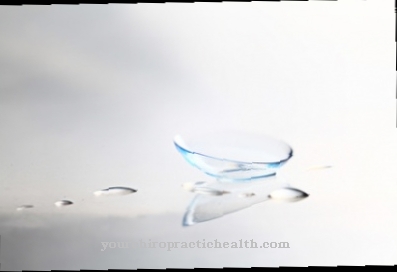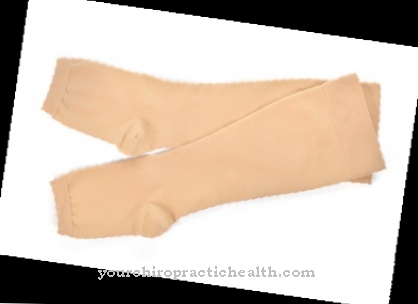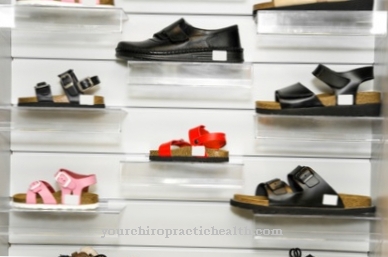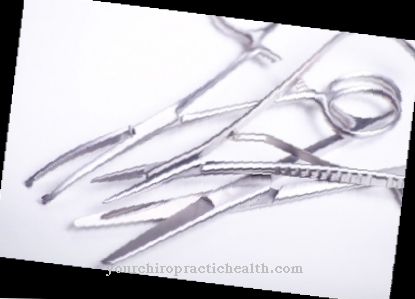Of the Pronation wedge is an orthopedically effective element of shoe technology and, like the supination wedge, is attached to so-called wedge soles or wedge inserts. The wedge shape compensates for misalignments of the foot axis that make it difficult for the foot to roll naturally. Pronation wedges are used, for example, for malpositions such as bow or knock knees, but also for symptoms such as clubfoot and ligament problems.
What is the pronation wedge?

Orthopedic shoe technology produces, among other things, various types of insoles with medical benefits. Medical insoles are particularly necessary if the feet are misaligned. Foot malpositions are, for example, the bent foot, the flat foot or the flat foot.
The insole technology supports the natural functions of the foot and counteracts incorrect posture, which can lead to functional losses and secondary diseases such as joint wear due to incorrect loading.
Different insoles are used for different malpositions and symptoms. One of them is the wedge insert or wedge sole. Wedge soles with an internally raised shape are called supination wedges. On the other hand, raised wedge inserts on the outside have a so-called pronation wedge, which brings the foot into pronation and accordingly rotates it inwards around its own axis. The outer edge of the foot is raised by the pronation wedge sole. The inner edge of the foot, however, lowers when used.
Both pronation and supination wedge soles are used, especially in the context of discomfort when rolling.
Shapes, types & types
The pronation wedge is made in the form of a wedge sole by the orthopedic shoe technician. The adjustment and the grinding are crucial for the effectiveness of the wedge sole. Accordingly, the pronation wedges of two patients always differ from one another. In terms of shape, type and type, the wedge soles are never the same, but depend on the shape of the foot and the patient's individual clinical picture.
The wedge soles also differ from one another with the use of different materials. The most frequently used materials are cork materials. Due to its air inclusions, cork exhibits physical properties such as elasticity. This means that the material does not behave rigidly. Rather, cork adapts to the foot and the weight of the patient and thus fulfills a bedding function instead of a rigid, supporting and guiding function. These properties make wedge soles or pronation wedges made of cork materials a relatively gentle correction of deformities.
In addition to cork, materials such as leather, felt and plastic can also be used in the pronation wedge. The corrective power to be achieved by the wedge is the decisive factor.
In addition to using the wedge sole on both sides, a one-sided use of the pronation wedge is also indicated for some clinical pictures. Typical heights of the design are three to five millimeters.
Structure & functionality
Pronation wedges are basically easy to use and can be inserted into many different shoes. As the name suggests, pronation wedges have a wedge or triangular shape. When attached to an insert, they are able to raise the outer edge of the patient's foot to a greater or lesser extent and at the same time lower the inner edge of the patient's foot to a greater or lesser extent.
By lifting the foot under the heel, the pronation wedge relieves the ligaments of the rear foot, including the miniscus. The pronation wedge supports the pronation of the foot, i.e. the natural, inward bending movement when the foot hits the ground.
Pronation is an essential part of natural movement. With a reduced pronation, but also with overpronation, complaints can occur in the long term. Pronation control can take place through the shoe itself using a pronation wedge. The wedge-shaped area on the inner midsole usually consists of a harder material on the outside and thus absorbs the buckling movement.
Pronation wedges are sometimes used most often in sports shoes, as the rolling movement is an essential movement, especially during physical movement. Misalignments of the foot or leg axis make a healthy rolling movement difficult and thus require the use of pronation or supination wedges.
As already noted above, a pronation wedge must be precisely adapted to the needs and dimensions of the wearer in order to achieve positive effects.
You can find your medication here
➔ Medicines for painMedical & health benefits
A very typical clinical picture with an indication of a continuous pronation wedge is valgusgon arthrosis or the so-called knock knees. Painful wear and tear on the knee joints can be a result of the knock-knees position. Usually the joint on the outside is affected. X-leg axis misalignments of the legs are either congenital or accidental.
Such a phenomenon can also occur after partial or complete removal of the external meniscus. If the knee is misaligned, the knee is exposed to uneven loading. The outside knee joint is overloaded and cartilage wear occurs.
In this context, the pronation wedge can support a repositioning operation. Successes can be expected after conversion operations, but these often evaporate again without further follow-up treatment.
In addition to the knock knees, misalignments such as bow legs can be an indication for the pronation wedge. The same applies to phenomena like the clubfoot. Both clinical pictures can require conservative insoles that usually have a flat pronation wedge to ensure the success of the surgical treatment.
Apart from these areas of application, the pronation wedge is also used for complaints, overloads and injuries to the outer ligaments. Such complaints are usually meniscus injuries which, if left untreated, can lead to secondary diseases.

























.jpg)


